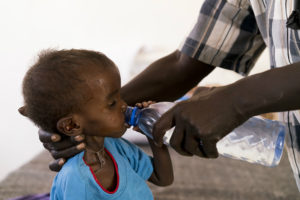
Fadumo Adam is 18 months old but the size of a newborn. Her parents brought her into the center five days ago.Adriane Ohanesian
MOGADISHU, Somalia — In the weeks after a historic transfer of power, there is hope in the streets of Somalia’s capital Mogadishu as the new president, Mohamed Abdullahi Farmajo, begins his term. Civil servants say they expect to be paid for the first time in a year. Residents hope the city can be rebuilt. And foreign troops here from across East Africa fighting al-Shabaab terrorists hope their mandate will finally come to an end.
“The election has been a big confidence boost for Somalis,” says Michael Keating, Special Representative of the U.N. Secretary-General (SRSG). “Somalis have just done something truly remarkable.”
But Farmajo’s first week has been trying. Al-Shabaab, at war with the Somali government for the last decade, has ramped up attacks on the new government, launching a deadly mortar attack aimed at the presidential palace and taking credit for a car bomb that killed 39 people.
Adapting to al-Shabaab’s shifting strategies will be a long-term challenge for the new administration, but the real test will be whether the new government can prevent a looming crisis: the starvation of its people.
Somalia is on the edge of famine, as severe drought threatens the entire country. Humanitarians say if nothing is done, it will be worse than the 2011 famine that killed a quarter-million people.
About 600 miles from Mogadishu, in Somalia’s Puntland region, every room in Garowe Hospital’s Stabilization Center is full of children under 5, most suffering from severe acute malnutrition.
Fadumo Adam is 18 months old but the size of a newborn. Her parents brought her into the center five days ago, unconscious and barely alive. Now, she lies on her side, mouth open, and tries to cry. She stretches her arm out toward a water bottle on the bed.
Her father, 70-year-old Adam Farrah, says she is doing much better as he lifts her up to pour some water into her mouth. A nurse explained she’s too weak to even sit up on her own.
On the bed near the window, Layla Mohammed holds her 15-month-old son, Issa. Covered in rashes, the child’s skin is shriveled and peeling off due to high fever. Issa also suffers from diarrhea and vomiting, brought on from drinking saltwater — the only thing available from the borehole, Layla says.
And these patients are the lucky ones, the staff insists.
“The ones here are the ones with means. We can’t reach everyone,” says Said Ahmed Yassin, 24, a nutritionist who oversees the stabilization center.
Three of Fadumo’s cousins have died of malnutrition in the past month, according to her father. All of them were younger than 10 years old. All of their camels died in the drought. Now, traveling to seek medical help is difficult and expensive.
Livestock herders like Adam Farrah are accustomed to lean times and cyclical drought. But he and other elderly herders across Puntland, now taking shelter in camps for the internally displaced, say the current challenges are different.
“I have seen many other droughts. This is the worst. Every few years we go through challenging times. But nothing like this, never,” Farrah says.
Over 6 million Somalis face the loss of their livestock-dependent livelihoods and risk acute malnutrition.
On the three-hour drive from Garowe to the Uusgure IDP camp, the main road is littered with the carcasses of goats and camels. Roadside water tanks dug into the ground are scorched and dry.
Source: Vice


